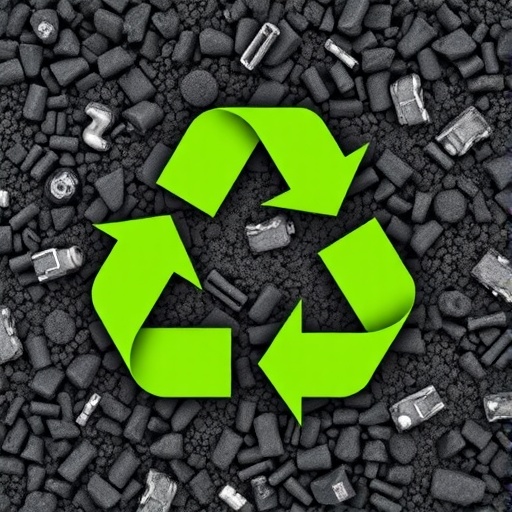In a groundbreaking study published in Environmental Science and Pollution Research, researchers Debnath, Singh, and Kuity delve into the innovative reuse of waste materials within the construction industry, specifically focusing on their application in bituminous mixtures. The era of environmental consciousness has spearheaded significant advancements in recycling and waste management, prompting scientists and engineers to explore sustainable alternatives that enhance material performance while simultaneously reducing the dependency on virgin resources. This review meticulously examines the incorporation of waste cooking oil, eggshells, glass, and plastic into asphalt mixtures, providing a detailed analysis of their contributions to both the performance of the materials and their environmental benefits.
The mounting pressures of global pollution and waste management have catalyzed a shift towards utilizing industrial and domestic waste products in various applications. As global consumption continues to rise, the disposal of waste cooking oil has become a critical environmental concern. This study highlights how waste cooking oil can serve not just as an environmental liability, but as a valuable resource when repurposed in bituminous mixtures. Incorporating this waste oil can enhance the flexibility and workability of asphalt, thereby improving the longevity and resilience of road infrastructures.
Eggshells, often dismissed as mere kitchen waste, possess unique properties conducive to materials engineering. The calcium carbonate-rich composition of eggshells offers notable structural benefits when added to asphalt mixtures. The researchers present compelling evidence that grinding eggshells into fine powders enhances the mechanical properties of bitumen, leading to improved performance under stress and elevated temperatures. This innovative use of an otherwise discarded material not only bolsters the quality of asphalt but also contributes to waste reduction and resource efficiency.
Glass, another ubiquitous waste material, demonstrates remarkable potential in the enhancement of asphalt. As urbanization accelerates, the production of glass waste rises alarmingly. The study underscores how finely crushed glass can be integrated into bituminous mixtures, providing an effective means to recycle this material while improving the stiffness and durability of asphalt. By utilizing glass in this manner, the researchers show that pavement performance is markedly enhanced, thus extending the lifespan of road surfaces and reducing the frequency of repairs.
Plastic waste, frequently categorized as one of the most detrimental pollutants globally, also finds its place in this innovative research. The incorporation of recycled plastic waste into asphalt formulations has been identified as a viable solution to mitigate the impacts of plastic pollution. The review highlights various types of plastics that can be effectively integrated into bituminous mixtures, emphasizing their ability to provide superior mechanical properties and flexibility. By addressing plastic waste challenges in this way, the potential for both superior pavement performance and reduced environmental impact is significant.
The researchers further discuss the environmental implications of their findings, reinforcing the notion that material sustainability is not merely an engineering challenge but a societal necessity. Increasing awareness and acceptance of recycling initiatives can turn waste products into valuable resources. The systematic review showcases how each of these waste materials not only contributes to improved material properties but also plays a crucial role in mitigating environmental issues.
A comprehensive analysis of previous studies validates the beneficial effects of these waste materials in asphalt. By aggregating and synthesizing existing literature, the authors provide a formidable argument for their adoption in engineering practices. This well-rounded approach allows for a clearer understanding of how incorporation strategies can differ, presenting numerous methods to integrate these waste products based on specific engineering requirements and local material availability.
The study also touches upon the economic ramifications associated with the adoption of waste materials in bituminous mixtures. Utilizing waste by-products can potentially reduce material costs significantly. Not only do these biodegradable inputs lower the demand for traditional asphalt ingredients, but they positively impact pricing for road construction and maintenance, providing an enticing prospect for municipalities and engineers alike facing budget constraints.
Moreover, the procedural aspects of introducing these waste materials into standard practices are examined in depth. The authors provide insights into the processing requirements, optimal ratios of waste materials to traditional components, and potential challenges that engineers might encounter during implementation. This thorough exploration serves as a practical guide for future research, aimed at transitioning these theories into real-world applications.
In sum, this study serves as an undeniable call to action within the construction and environmental engineering fields. Debnath, Singh, and Kuity’s meticulous review encapsulates not just the technical benefits of utilizing waste materials in asphalt, but also the broader impact on environmental stewardship, sustainability, and resource conservation. Their findings showcase a promising path forward for the construction industry, representing a harmonious convergence of ecological responsibility and civil engineering.
As the call for sustainability in various industries grows louder, the insights gleaned from this research may inspire a wave of innovation, ultimately reshaping the way we view and utilize waste materials in construction. The authors eloquently encourage the exploration of other potential waste sources, hinting at a future where sustainability is not an afterthought but the cornerstone of engineering design.
With this review marking an important milestone in the quest for sustainable practices, it paves the way for further exploration of effective methods to incorporate various waste materials into a myriad of applications. In doing so, researchers, engineers, and industry stakeholders can work collaboratively towards achieving a circular economy—where waste is regarded not as a burden but as an invaluable resource to foster a more sustainable future.
Subject of Research: Utilization of Waste Materials in Bituminous Mixtures
Article Title: A Review Study on Utilization of Waste Cooking Oil, Eggshell, Glass, and Plastic in Bituminous Mixtures
Article References:
Debnath, J., Singh, K.L. & Kuity, A. A review study on utilization of waste cooking oil, eggshell, glass, and plastic in bituminous mixtures.
Environ Sci Pollut Res (2025). https://doi.org/10.1007/s11356-025-37129-1
Image Credits: AI Generated
DOI: 10.1007/s11356-025-37129-1
Keywords: Waste cooking oil, eggshell, glass, plastic, bituminous mixtures, sustainable materials, recycling, environmental impact.




